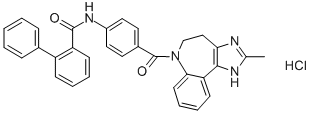Arginine vasopressin is intimately involved in volume homeostasis, and
elevated levels of arginine vasopressin are responsible for the pathogenesis and
progression of diseases with an imbalance of sodium and water, particularly
congestive heart failure. To restore homeostasis, antagonism of vasopressin
receptors is a practical solution. As such, conivaptan has been developed and
launched as a dual V1a and V2 vasopressin receptor antagonist. As a competitive,
reversible inhibitor of both subtypes, conivaptan can modulate systemic vascular
resistance through the V1a receptor (Ki ? 0.48 nM) distributed in vascular smooth
muscle cells, cardiomyocytes, hepatocytes, and platelets and blocks the renal V2
receptor (Ki ? 3.04 nM) resulting in enhanced diuresis, thereby increasing serum
sodium concentration and reducing total body volume. Currently, the drug is
approved for the management of refractory hyponatremia and potentially lifethreatening
sodium and water imbalance, but it has shown promise as a potential
treatment option for other diseases, such as congestive heart failure, syndrome of
antidiuretic hormone, diabetes insipidus, and liver cirrhosis.

